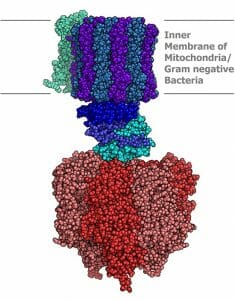ATP Synthase Definition
ATP synthase is an enzyme that directly generates adenosine triphosphate (ATP) during the process of cellular respiration. ATP is the main energy molecule used in cells. ATP synthase forms ATP from adenosine diphosphate (ADP) and an inorganic phosphate (Pi) through oxidative phosphorylation, which is a process in which enzymes oxidize nutrients to form ATP. ATP synthase is found in all lifeforms and powers all cellular activities.
Function of ATP Synthase
The function of ATP synthase is to produce ATP. ATP is necessary to power all cellular processes, so it is constantly being used by cells and constantly needs to be produced. Each ATP synthase can produce about 100 molecules of ATP every second. Eukaryotes, such as plants, animals, and fungi, have organelles called mitochondria that mainly function as ATP producers. Plants also have chloroplasts that contain ATP synthase and can produce ATP from sunlight and carbon dioxide. Bacteria and archaea, which make up the prokaryotes, do not have mitochondria but produce ATP through similar cellular respiration processes in their plasma membrane. Across all forms of life, ATP synthase has basically the same structure and function. Therefore, it is thought to have evolved early on in the evolution of life, and would have been found in the last common ancestor of all life on Earth.
Structure of ATP Synthase
ATP Synthase has two parts. The part embedded within the membrane of the mitochondria (in eukaryotes), thylakoid membrane of the chloroplast (only in plants), or plasma membrane (in prokaryotes) is called FO. This is a motor that is powered by H+ ions flowing across the membrane. The part within the mitochondria, stroma of the chloroplast, or inside the bacterial or archaeal cell is called F1-ATPase. This is another motor that is used to generate ATP. These two parts are thought to have been two separate structures with two different functions that eventually evolved into ATP synthase. The FO region is similar to DNA helicases (enzymes that unzip DNA so that it can be used as a template for reproduction), while the F1-ATPase region is similar to the H+ motors that allow flagella, arm-like appendages on some bacteria, to move. F1-ATPase has a central stalk and rotor that, when turned, converts ADP and Pi into ATP.
This is a rendering of the structure of ATP synthase. FO is shown in blue and purple, while F1-ATPase is shown in red.

ATP Synthesis
ATP is produced through different methods: through cellular respiration in the mitochondria, during photosynthesis in the chloroplasts of plants, and across the inner membrane of bacteria and archaea, which do not have mitochondria. Although the methods of ATP production vary across different types of organisms, they all follow a similar basic procedure.
In the mitochondria of eukaryotes, the molecules NADH and FADH2, which are products of the citric acid cycle, pass electrons down an electron transport chain, where they travel through three different protein complexes. This process releases energy, and this energy allows protons (H+ ions) to travel down a proton gradient through the protein complexes, which act as proton pumps. The flow of these protons down the gradient turns the rotor and stalk of the ATP synthase, which makes it possible for a phosphate group to join with adenosine diphosphate (ADP), forming ATP. In chloroplasts, the process is similar, except light energy is the type of energy that excites electrons, causing them to flow down the electron transport chain and enable H+ ions to travel through a membrane in the chloroplast. These methods are similar in very different organisms since the ability to generate ATP existed in the common ancestor of all living organisms.
Related Biology Terms
- Adenosine triphosphate (ATP) – The main energy molecule used by the cell.
- Eukaryotes – Organisms that have eukaryotic cells, which are complex cells with a true nucleus and organelles.
- Mitochondria – The organelle in the cells of eukaryotes that produces ATP.
- Chloroplast – The organelle in plant cells that, in addition to mitochondria, produces ATP through photosynthesis.
Quiz
1. Which organisms do not have mitochondria?
A. Bacteria
B. Animals
C. Plants
D. Fungi
2. Which component is not part of the ATP synthesis process?
A. Electron transport chain
B. Proton gradient
C. Flagella
D. Rotor and stalk of ATP synthase
3. Which part of ATP synthase is a motor?
A. FO
B. F1-ATPase
C. Both
D. Neither
